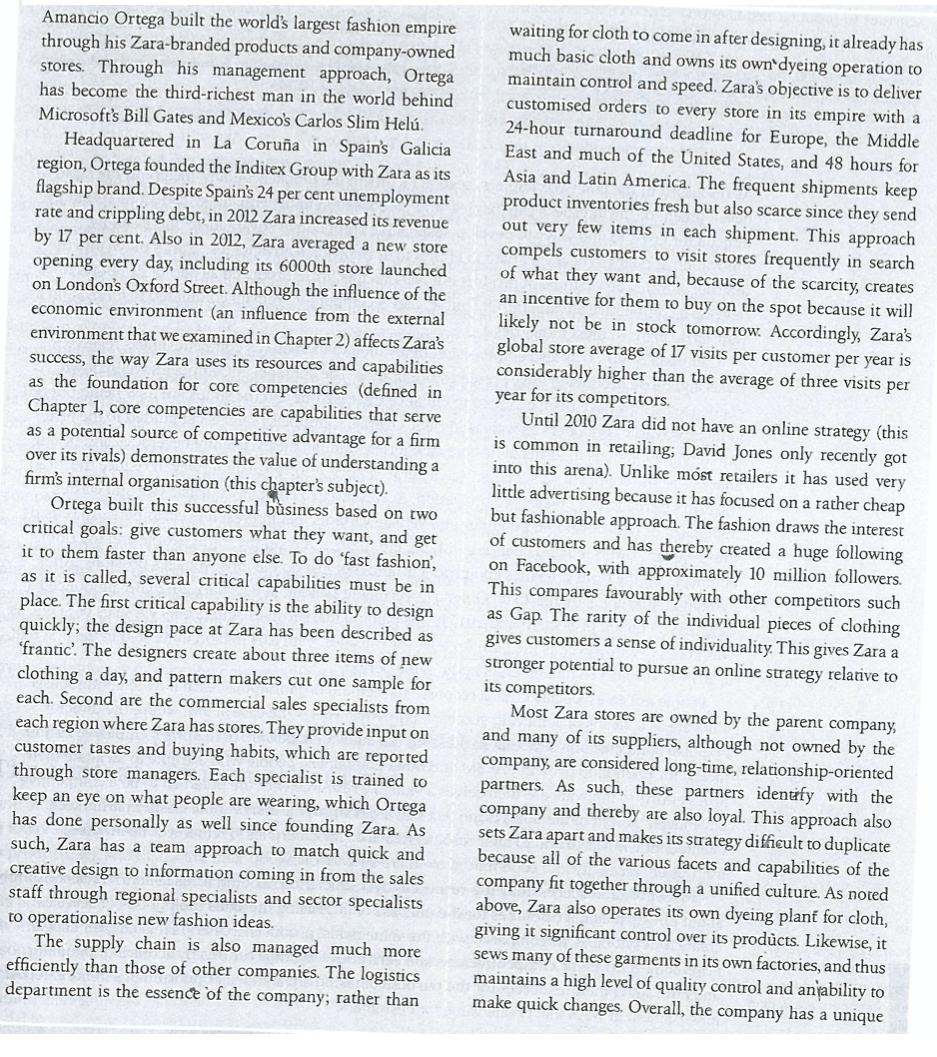Answered step by step
Verified Expert Solution
Question
1 Approved Answer
Examine the Zara mini-case and identify their Tangible and Intangible resources. Identify and explain the sources of Zaras capabilities. Identify and briefly explain the source
 Examine the Zara mini-case and identify their Tangible and Intangible resources.
Examine the Zara mini-case and identify their Tangible and Intangible resources.
- Identify and explain the sources of Zara’s capabilities.
- Identify and briefly explain the source of Zara’s competitive advantage using the four (4) criteria of sustainable competitive advantage.
Amancio Ortega built the world's largest fashion empire through his Zara-branded products and company-owned stores. Through his management approach, Ortega has become the third-richest man in the world behind Microsoft's Bill Gates and Mexico's Carlos Slim Hel. Headquartered in La Corua in Spain's Galicia region, Ortega founded the Inditex Group with Zara as its flagship brand. Despite Spain's 24 per cent unemployment rate and crippling debt, in 2012 Zara increased its revenue by 17 per cent. Also in 2012, Zara averaged a new store opening every day, including its 6000th store launched on London's Oxford Street. Although the influence of the economic environment (an influence from the external environment that we examined in Chapter 2) affects Zara's success, the way Zara uses its resources and capabilities as the foundation for core competencies (defined in Chapter 1, core competencies are capabilities that serve as a potential source of competitive advantage for a firm over its rivals) demonstrates the value of understanding a firm's internal organisation (this chapter's subject). Ortega built this successful business based on two critical goals: give customers what they want, and get it to them faster than anyone else. To do 'fast fashion, as it is called, several critical capabilities must be in place. The first critical capability is the ability to design quickly; the design pace at Zara has been described as 'frantic'. The designers create about three items of new clothing a day, and pattern makers cut one sample for each. Second are the commercial sales specialists from each region where Zara has stores. They provide input on customer tastes and buying habits, which are reported through store managers. Each specialist is trained to keep an eye on what people are wearing, which Ortega has done personally as well since founding Zara. As such, Zara has a team approach to match quick and creative design to information coming in from the sales staff through regional specialists and sector specialists to operationalise new fashion ideas. The supply chain is also managed much more efficiently than those of other companies. The logistics department is the essence of the company; rather than waiting for cloth to come in after designing, it already has much basic cloth and owns its own dyeing operation to maintain control and speed. Zara's objective is to deliver customised orders to every store in its empire with a 24-hour turnaround deadline for Europe, the Middle East and much of the United States, and 48 hours for Asia and Latin America. The frequent shipments keep product inventories fresh but also scarce since they send out very few items in each shipment. This approach compels customers to visit stores frequently in search of what they want and, because of the scarcity, creates an incentive for them to buy on the spot because it will likely not be in stock tomorrow. Accordingly, Zara's global store average of 17 visits per customer per year is considerably higher than the average of three visits per year for its competitors. Until 2010 Zara did not have an online strategy (this is common in retailing, David Jones only recently got into this arena). Unlike most retailers it has used very little advertising because it has focused on a rather cheap but fashionable approach. The fashion draws the interest of customers and has thereby created a huge following on Facebook, with approximately 10 million followers. This compares favourably with other competitors such as Gap. The rarity of the individual pieces of clothing gives customers a sense of individuality. This gives Zara a stronger potential to pursue an online strategy relative to its competitors. Most Zara stores are owned by the parent company, and many of its suppliers, although not owned by the company, are considered long-time, relationship-oriented partners. As such, these partners identify with the company and thereby are also loyal. This approach also sets Zara apart and makes its strategy difficult to duplicate because all of the various facets and capabilities of the company fit together through a unified culture. As noted above, Zara also operates its own dyeing plant for cloth, giving it significant control over its products. Likewise, it sews many of these garments in its own factories, and thus maintains a high level of quality control and an ability to make quick changes. Overall, the company has a unique
Step by Step Solution
★★★★★
3.40 Rating (166 Votes )
There are 3 Steps involved in it
Step: 1
1TANGIBLE RESOURCES Basically the financial segment of Zara that is very strong and competitive in nature and the financial performance of Zara explains its heavy amount of earnings and profit margins ...
Get Instant Access to Expert-Tailored Solutions
See step-by-step solutions with expert insights and AI powered tools for academic success
Step: 2

Step: 3

Ace Your Homework with AI
Get the answers you need in no time with our AI-driven, step-by-step assistance
Get Started


